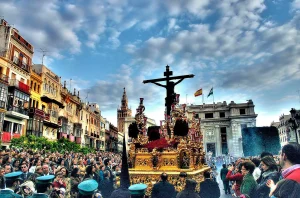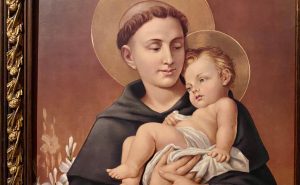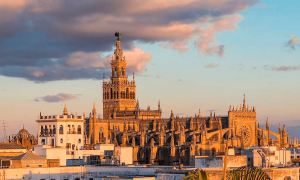
The Manila shawl: An Andalusian ornament?
For those ones who still do not know what we mean when we talk about the Sevillian “Mantón de Manila“, we can define it using the words of the well-known realist writer Benito Pérez Galdós, who in his most important novel, Fortunata y Jacinta, writes: “to wrap oneself in it, is like dressing in a painting…”, and the fact is that the shawl is a silk embroidered fabric canvas with vivid colors based on diverse elements, such as: flowers, birds, elements inspired by fantasy… and finished off with bangs.
In this new blog entry we question the Andalusian origin of this accessory, used by women as a luxurious piece of clothing, and is that as its own name refers, its origin is not from Andalusia and this is precisely what we are going to talk about on this occasion.
The popular Manila shawl comes from the Chinese city of Canton, popular for its silk embroidery, but we speak of Manila because in the fifteenth century was the port of Manila through which goods were shipped to Seville, whose port on the Guadalquivir River, became after the Discovery of America, one of the most important worldwide.
In these years, the evolution of the shawl has been quite significant, and is that originally they were quite different from what we know today, because if today they are brightly colored and quite large dimensions, in its origins were dark colors, small and with little decoration in silk. In addition, the initial motifs of their decoration had nothing to do with the current ones, since they began as shawls decorated with Asian motifs (dragons, lotus flower…) and later with the European influence came roses, red carnations, birds… (motifs much appreciated in Andalusia), as well as a much thicker silk fabric.
As a complement to women’s clothing, the shawl had its moment of fashion, being its peak in the eighteenth century, when the women of high society used it to cover their shoulders delicately. With the passage of time, it descended to the less wealthy classes, also reaching flamenco, where it brings to the dance a complicated technique that requires great mastery to move the shawl to the beat.
Today the Manila shawl is considered a typical garment of Andalusian craftsmanship and is used by women in popular events: April Fair, as a complement to the regional dress, to go to the bulls, or even used to decorate the balconies of the houses on certain holidays, for example on the occasion of Corpus Christi, the day of the Patron Saint of the city, etc.

The Manila shawl: An Andalusian ornament?
For those ones who still do not know what we mean when we talk about the Sevillian “Mantón de Manila“, we can define it using the words of the well-known realist writer Benito Pérez Galdós, who in his most important novel, Fortunata y Jacinta, writes: “to wrap oneself in it, is like dressing in a painting…”, and the fact is that the shawl is a silk embroidered fabric canvas with vivid colors based on diverse elements, such as: flowers, birds, elements inspired by fantasy… and finished off with bangs.
In this new blog entry we question the Andalusian origin of this accessory, used by women as a luxurious piece of clothing, and is that as its own name refers, its origin is not from Andalusia and this is precisely what we are going to talk about on this occasion.
The popular Manila shawl comes from the Chinese city of Canton, popular for its silk embroidery, but we speak of Manila because in the fifteenth century was the port of Manila through which goods were shipped to Seville, whose port on the Guadalquivir River, became after the Discovery of America, one of the most important worldwide.
In these years, the evolution of the shawl has been quite significant, and is that originally they were quite different from what we know today, because if today they are brightly colored and quite large dimensions, in its origins were dark colors, small and with little decoration in silk. In addition, the initial motifs of their decoration had nothing to do with the current ones, since they began as shawls decorated with Asian motifs (dragons, lotus flower…) and later with the European influence came roses, red carnations, birds… (motifs much appreciated in Andalusia), as well as a much thicker silk fabric.
As a complement to women’s clothing, the shawl had its moment of fashion, being its peak in the eighteenth century, when the women of high society used it to cover their shoulders delicately. With the passage of time, it descended to the less wealthy classes, also reaching flamenco, where it brings to the dance a complicated technique that requires great mastery to move the shawl to the beat.
Today the Manila shawl is considered a typical garment of Andalusian craftsmanship and is used by women in popular events: April Fair, as a complement to the regional dress, to go to the bulls, or even used to decorate the balconies of the houses on certain holidays, for example on the occasion of Corpus Christi, the day of the Patron Saint of the city, etc.






